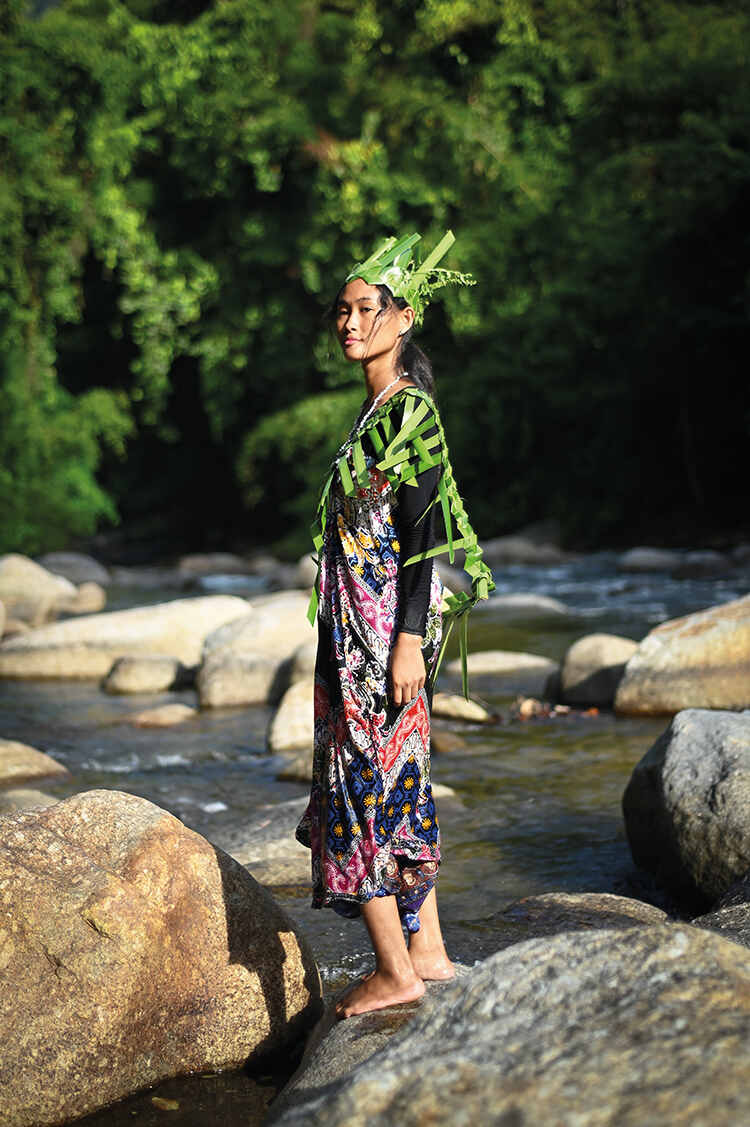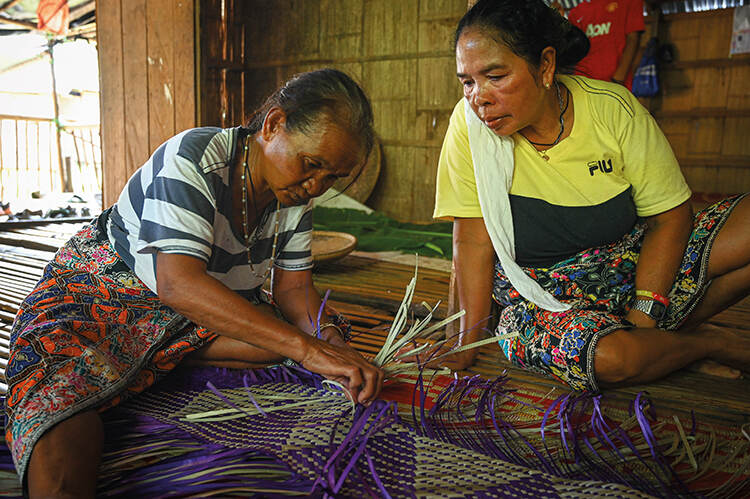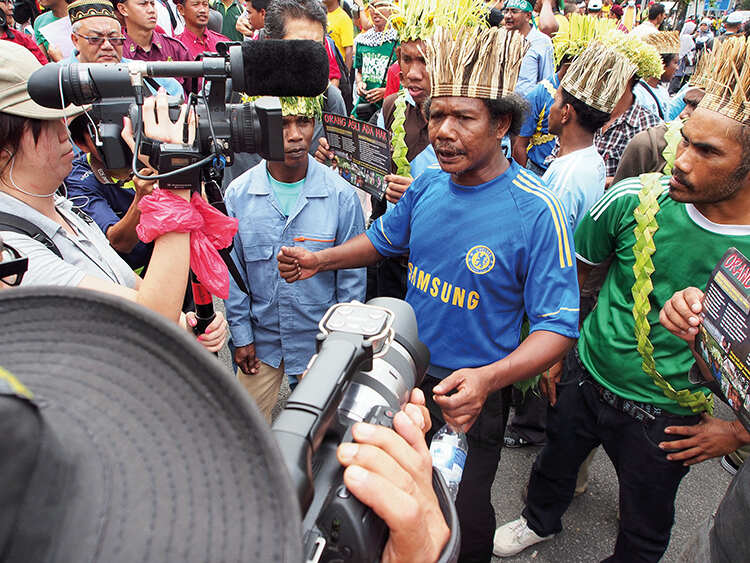
The Orang Asli tribe of Peninsular Malaysia, faced with increasing demand for land over which they have few rights, are struggling to maintain their traditional way of life
Words and photographs by Izzy Sasada
Daud a/l Bah Belon sits cross-legged on the forest floor, weaving dried plant material together to make a traditional woven basket. The 43-year-old is a senior member of the Semai Orang Asli tribe of Ulu Jelai Forest Reserve in Pahang state, Malaysia.
Most weeks, Daud will trek in the forest near his village to collect the fibres and other plant materials required for the practice of craft-making. It’s a job that requires patience; crafters can sit for entire afternoons and evenings inside traditional elevated bamboo huts, and each woven basket can take weeks or even months to make. Daud’s community has resided in Ulu Jelai for generations, but now, the forest in which he collects materials is under threat.
A micro-hydro dam is being built in Pos Lenjang, the area of the reserve in which Daud’s community lives. Despite significant resistance to the project, swathes of forest have already been cut down for roads to give machinery and workers access to the remote location. The micro-hydro project, which villagers fear will pollute their waters and encroach upon their sacred sites, will be completed by the end of this year.

Today, there are about 220,000 Orang Asli in Peninsular Malaysia – a term meaning ‘first’ or ‘native’ people that includes numerous Indigenous groups. As in other Orang Asli communities, members of the Semai community in Pos Lenjang depend on their surroundings for all aspects of their lives, including food, medicine and materials to build furniture and houses.
‘Without the forest it would be hard to live,’ says Bah Sugi, a younger member of the community who spent ten years as a factory worker in the country’s capital, Kuala Lumpur, before returning to the village life he prefers. ‘We catch squirrels to eat and we make spears for hunting from the trees.’
The forest is also home to the plant materials that Semai weavers use to make their handcrafts. Common materials such as rattan and pandanus leaves, which are found in the forest, are woven together to make baskets, accessories and rucksacks, as well as furniture such as benches, floor mats and even the walls of traditional Orang Asli houses. With the assistance of local NGOs, craft-makers earn a supplementary income by selling their wares to cities and towns. Although cash-poor, Orang Asli have provided for themselves through forest resources and subsistence farming for generations.

‘Money isn’t everything here,’ according to Bek Raheed, another member of the Pos Lenjang community. Bek Raheed grew up in Sarawak, on neighbouring Borneo, but has lived in the settlement since 1997 after marrying his wife, who belongs to the Semai community. He runs an educational centre and homestay in Pos Lenjang, which welcomes researchers and the occasional tourist group.
‘It’s not like the outside,’ he explains. ‘It’s possible to live without money; they will still have food to eat. The government labels the Orang Asli as poor. ‘Technically it’s true, but they’ve never seen themselves as poor.’
Increasingly, Orang Asli communities are losing access to their land, through deforestation, logging and other developments, such as hydropower plants. Hydropower is increasingly important in meeting Malaysia’s energy and climate goal of reaching net-zero emissions by 2050. But often, such projects are at the expense of Indigenous livelihoods. For Colin Nicholas, who founded the Center for Orang Asli Concerns in 1989, it’s no coincidence that Orang Asli territoriy is commonly targeted for hydro projects.

‘If you look at the map of Peninsular Malaysia, you will see areas where there are still forests; this is where the Orang Asli mainly live,’ Nicholas says. ‘The Orang Asli, through their indigenous systems of land management and use, have been protecting and conserving these areas, which are now the last remaining resource frontiers in the peninsula.’
While the project in Pos Lenjang is small, it’s unlikely that the community will be forced to move. In the past, however, entire communities in Peninsular Malaysia and on Borneo have been relocated for hydropower projects. And hydropower isn’t the only factor contributing to the Orang Asli’s loss of land.
The last few decades have seen Malaysia develop rapidly, assisted by industries including timber, rubber and palm oil. Today, the country is the second-biggest producer of palm oil, responsible for around a third of the world’s supply; the industry contributes 2.5 per cent of the Malaysia’s GDP.

The scramble for lucrative materials and haste to clear vast tracts of land for plantations has led to environmental devastation across the country. Between 2002 and 2022, Malaysia lost 2.85 million hectares of humid primary forest, making up a third of its total tree cover loss over the same time period. Between 2000 and 2012, Malaysia had the highest rate of deforestation in the world.
Today, many Indigenous communities exist on land that’s perceived to be valuable by outsiders with interests in timber and minerals, and for conversion into plantations. Encroachment into native land has led to the lowering of living standards among Orang Asli communities. When land is infringed upon by outsiders, basic rights to water, food and health are jeopardised.
Today, the average lifespan of the Orang Asli is around 50 years. They have the lowest literacy rates in the country, are the most malnourished group and are frequently discriminated against.
‘The biggest threat to the Orang Asli is that their land is not recognised,’ says Bek Raheed. ‘They get moved to new settlements when their land is needed. These new settlements don’t offer the same resources as their ancestral land. Without the forest, it is very difficult for them to continue their traditions.’

Loss of land is leading to loss of cultural knowledge. The practice of craft-making for example, depends upon access to healthy forests; for every path cleared for projects such as hydro dams, the scarcity of plants for craft-making is increased.
‘The crafts become extremely limited if you go to an area where Orang Asli are surrounded by oil palm,’ says Wendi Sia, who runs a collective called Gerimis that produces artwork in collaboration with the Pos Lenjang Semai craft-makers. ‘To be able to do crafts, you need resources, and to be able to get those resources, you need to have a viable territory.’
At the heart of most of these battles for land is the fact that most Orang Asli communities don’t own the land on which they reside. The key piece of existing legislation dealing with the Orang Asli, the 1954 Aboriginal Peoples Act, deems that most of the forests they depend upon are owned by the Malaysian government, with very few areas recognised as belonging to Indigenous groups. Global NGO Minority Rights estimates that less than 20 per cent of Orang Asli villages in Malaysia are gazetted and set aside as Orang Asli areas or reserves.

‘They are seen as squatters on the land, or the term used in law is “tenants at will”,’ says Nicholas. ‘This means they are tenants, not the owners, and if someone else wants the land, they have to go. They often get compensation for encroachment, but most people don’t want the cash.’
Increasing conflict over land has led to protests, courtroom battles and even cases where Orang Asli communities have erected blockades to stop loggers from entering their villages. There’s significant community resistance to the micro-hydro dam in Pos Lenjang. While the project is said to have been approved by the batin, or village headman, many in the community don’t favour it because it will be built near the community’s sacred hot spring.
‘The hot spring is the source of life of this forest,’ according to elder Bah Singin. It’s believed that spirits pass through the hot spring after a person dies; the water isn’t drunk but is reserved for healing practices.

While many in the community aren’t against development as a whole, they argue that they weren’t afforded the right of prior informed consent for a project that will take place on their land.
Reports by activist groups, including Amnesty International, indicate that in Peninsular Malaysia, the government has a habit of appointing batins without adequately consulting the community. They then receive a monthly salary from state authorities, incentivising them to sign off on development projects. In many communities, these headmen side with the government.
The system of appointed headmen undermines the Orang Asli’s ability to self-govern and to choose leaders in accordance with their own procedures. Traditionally, there were no headmen in Semai society and it lacked a formal leadership structure. Instead, elders were consulted for most issues affecting the community, including conflict resolution.

The community in Pos Lenjang – like other Orang Asli communities – can see the benefit of some development projects. Enhanced roads provide economic opportunities for remote communities, as well as better access to health and educational facilities. ‘A road could help us sell crops to the city,’ says Raheed, Bek Raheed’s son, ‘it could help bring sick people out for medical attention.’
However, those in the community say they should have the right to self-determination when it comes to development projects. ‘As a Malaysian and someone who lives here – I want them to develop, while maintaining their land, forest and traditions,’ says Bek Raheed, ‘They should let the Orang Asli develop on their own terms.’
Past policies aimed at modernising or drawing Orang Asli people into mainstream society have had varying success. One such initiative saw government-funded concrete houses built in villages, but they were often quickly abandoned in favour of traditional bamboo houses that provide better insulation against the heat.
The Orang Asli possess invaluable knowledge about living harmoniously with nature. By displacing them from their natural habitat, we risk losing centuries-old wisdom, from intricate plant-identification techniques to the artistry of crafting essential tools and beautiful objects. In Pos Lenjang, further destruction of rainforest seems imminent as the hydro project is set to move forward in the coming months; the community will have to survive from what’s left of their dwindling forests.
Indigenous territories may be perceived as occupying large spaces by outsiders, but their forest homes consist of sacred sites, ancestral graves and places for hunting, planting and foraging for rattan, bamboo or medicines.
‘Loggers just see a forest and valuable trees,’ Nicholas says. ‘For the Orang Asli, it is more than that. Logging is like bulldozing your archaeological sites and smashing down your museums, archives, cemeteries and cathedrals. It is their hardware store where they get their building materials, their pharmacy where they get their medicines and their archaeological sites where the bones of their ancestors are buried.’
For Nicholas, who has been campaigning for Orang Asli land rights for decades, this kind of encroachment and the displacement of communities infringes on their human rights. ‘To be able to enjoy full, dignified lives as an Orang Asli and a human being, an Orang Asli needs to have the environment, the resources, the space – in other words, his customary land – in his control and in good condition. This is not an entitlement. It is a right.’



